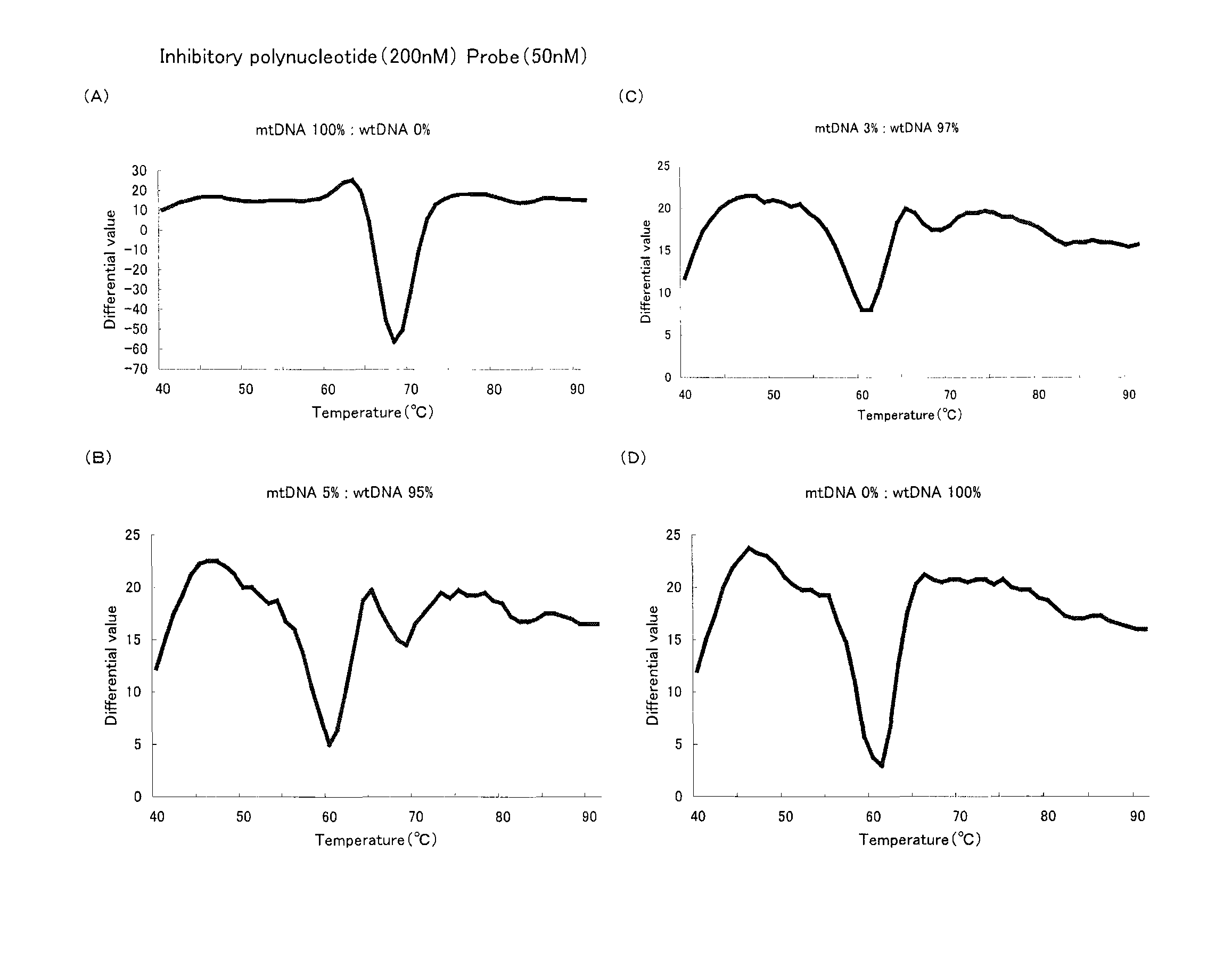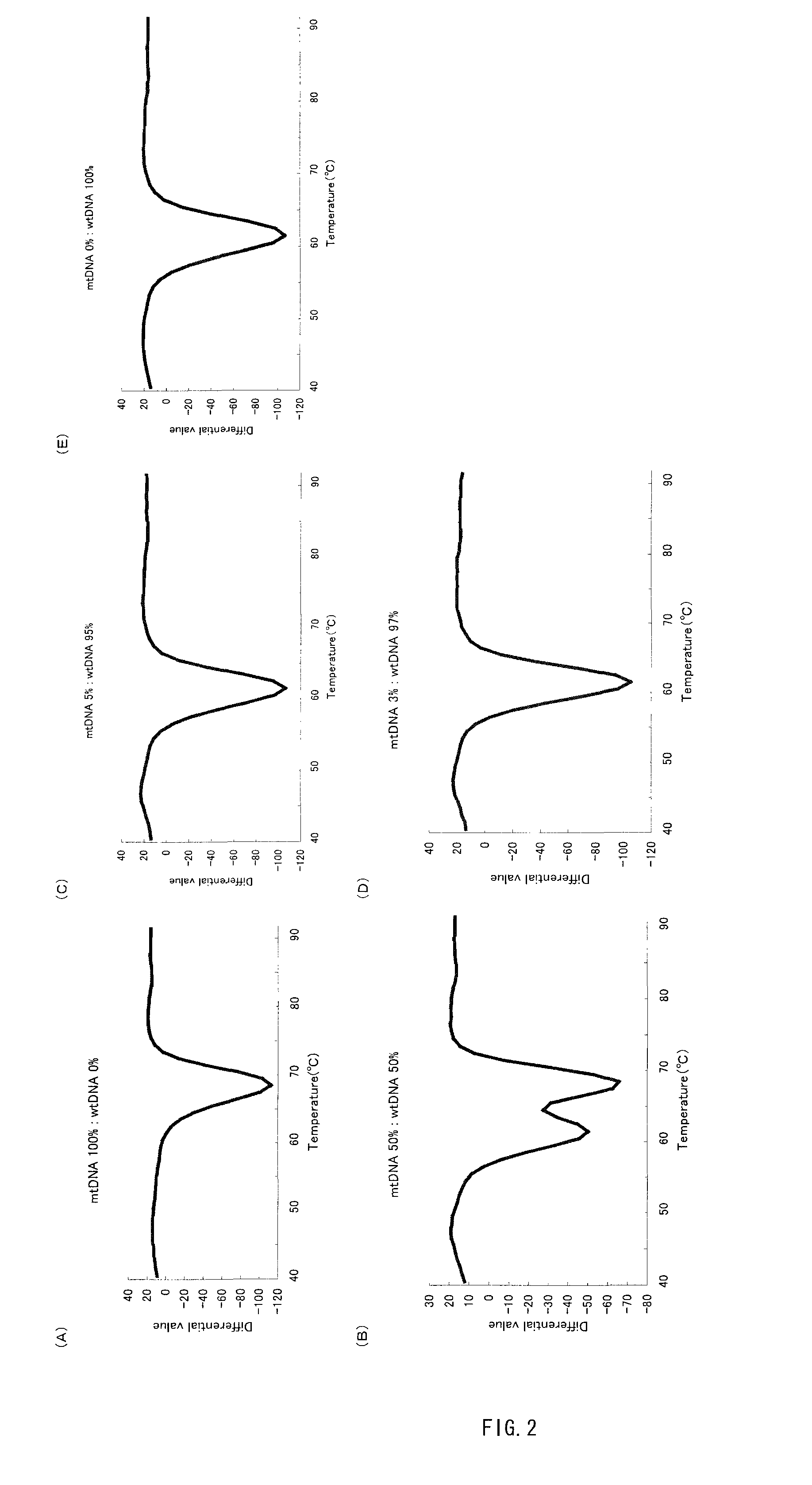Method of detecting mutation and kit used in the same
a technology of mutation and kit, which is applied in the field of methods of detecting mutations and kits, can solve the problems of not being able to analyze the site and type of mutations, require a considerable amount of time and labor for their operations, and not be very sensitive, and achieve the effect of suppressing the hybridization of the detection probe to the sequence not to be detected, and facilitating the operation
- Summary
- Abstract
- Description
- Claims
- Application Information
AI Technical Summary
Benefits of technology
Problems solved by technology
Method used
Image
Examples
example 1
Point Mutation at 758th Base in Abl Gene (A to T)
[0076](1) With an inhibitory polynucleotide added, the Tm analysis with respect to the point mutation at the 758th base (A to T) in the abl gene was performed.
[0077]Genomic DNA derived from a leukocyte cell line containing no mutation at the 758th base in the abl gene (Sequence No. 1) and genomic DNA derived from a leukocyte cell line containing a mutation at the 758th base in the abl gene (the 758th base is T in Sequence No. 1: abl tyrosinkinase A758T (=Y253F)) were prepared. Hereinafter, the former containing no mutation is referred to as ‘wtDNA’ and the latter containing a mutation as ‘mtDNA’. These two were mixed at predetermined ratios (mtDNA:wtDNA=10:0, 50:50, 10:90, 5:95, 3:97, 0:100). Then 104 copy / test (1 μL) of the resultant mixture was added to 50 μL of the PCR reaction solution described below and thereby a PCR reaction was carried out. The final concentration of the inhibitory polynucleotide in the aforementioned PCR reac...
example 2
Point Mutation at 756th Base in Abl Gene (G to C)
[0084]With an inhibitory polynucleotide added, the Tm analysis with respect to the point mutation at the 756th base (G to C) in the abl gene was performed.
[0085]A plasmid into which a normal abl gene sequence containing no mutation at the 756th base G of Sequence No. 1 had been inserted and a plasmid into which a mutated abl gene with the 756th base G mutated to C (abl tyrosinkinase G756C (=Q250E)) had been inserted were prepared. Hereinafter, the former containing no mutation is referred to as ‘wtDNA’, and the latter containing a mutation as ‘mtDNA’. In the same manner as in Table 1 in Example 1 described above, these two were mixed at predetermined ratios (mtDNA:wtDNA=0:100, 3:97, 100:0). Then 104 copy / test (1 μL) of the resultant mixture was added to 49 μL of the PCR reaction solution described below and thereby a PCR reaction was carried out. The final concentration of the inhibitory polynucleotide in the PCR reaction solution was...
example 3
Point Mutation at 763rd Base in Abl Gene (G to A)
[0088]With an inhibitory polynucleotide added, the Tm analysis with respect to the point mutation at the 763rd base (G to A) in the abl gene was performed.
[0089]A plasmid into which a normal abl gene sequence containing no mutation at the 763rd base G of Sequence No. 1 had been inserted and a plasmid into which a mutated abl gene with the 763rd base G mutated to A (abl tyrosinkinase G763A (=E255K)) had been inserted were prepared. Hereinafter, the former containing no mutation is referred to as ‘wtDNA’, and the latter containing a mutation as ‘mtDNA’. In the same manner as in Table 1 in Example 1 described above, these two were mixed at predetermined ratios (mtDNA:wtDNA=0:100, 3:97, 100:0). Then, 104 copy / test (1 μL) of the resultant mixture was added to 49 μL of the PCR reaction solution described below and thereby a PCR reaction was carried out. The final concentration of the inhibitory polynucleotide in the PCR reaction solution wa...
PUM
| Property | Measurement | Unit |
|---|---|---|
| molar ratio | aaaaa | aaaaa |
| detection wavelength | aaaaa | aaaaa |
| detection wavelength | aaaaa | aaaaa |
Abstract
Description
Claims
Application Information
 Login to View More
Login to View More - R&D
- Intellectual Property
- Life Sciences
- Materials
- Tech Scout
- Unparalleled Data Quality
- Higher Quality Content
- 60% Fewer Hallucinations
Browse by: Latest US Patents, China's latest patents, Technical Efficacy Thesaurus, Application Domain, Technology Topic, Popular Technical Reports.
© 2025 PatSnap. All rights reserved.Legal|Privacy policy|Modern Slavery Act Transparency Statement|Sitemap|About US| Contact US: help@patsnap.com



